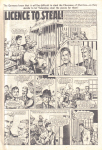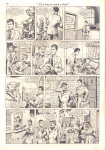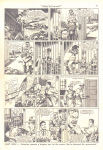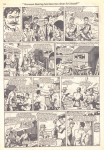

See The Victor 380 (1st June 1968) to 394 (7th Sept. 1968).
Writer:- The Victor editorial team. Artist:- Not known. (This artist also drew the The Bombs of the Purple Stripe).
Main cast:- Jimmy Valentine, international art thief; Baggot, his warder.
Time period:- German occupied Europe, 1940, Second World War.
This is a light-hearted romp around German occupied Europe, in the tradition of E.W. Hornung's Raffles stories. Jimmy Valentine is an international art thief, who at the beginning of the series is doing porridge as a guest at one of His Majesty's prisons. He is however, given the choice of remaining in prison or being given a free pardon, on the condition that he 'liberates' certain pieces of art from various European museums and private residences. In an unusual step, his assistant is his warder, Baggot. The pair both move quite freely around different occupied European countries without arousing any suspicions. Despite the fact that Baggot wears his flat cap and can't speak any other language, apart from English.
The German Reichmarshal Herman Goering, using a squad of so called art collectors is stealing valueable works of art. The British want to stop these thefts by convincing the owners of the pieces of art, to send them to Britain for safe-keeping. Valentine's skills as a thief, will only be required if the owners refuse to hand over the art. In other words Valentine is to 'liberate' the works, with the backing of the British Government.
Valentine's character is one of always being the cheerful, happy go lucky, never one to be down-hearted type. Baggot does all of the worrying and is always convinced that they will be caught. Although he's no fool and is always reminding Valentine that it's best to remain on the right side of the law. Even when Valentine attempts to steal small items, Baggot's eagle eye misses nothing.
The stories are good, being well scripted, with our heroes each week matched against Goering's 'art collectors'. There is always an obstacle to overcome, a counter plan to be hatched by Valentine before the various art treasures can be 'liberated'. Valentine tends to use his brains rather than brawn to obtain the pieces of art. Each week after he has beaten the Germans to the art treasure, he leaves his calling card. (See the image above.) Some of the writing in the scripts is from the corny comic school of writing. For example, 'We have been tricked by that British pig-dog! He just laughs at us!' (issue 385).
Triva corner:- the actor Anthony Valentine played Raffles in the British TV series in the late 1970's.
Historical Note.
This strip like many other war stories in both The Victor and The Hornet are based on true historical facts. Nazi Germany did indeed loot the countries they invaded of its art treasures. (If the Germans had succeeded in invading Great Britain art treasures and monuments such as Lord Nelson’s column would have been disassembled and shipped back to Germany).
‘It would appear that there were two inspirations for the Nazi plunder of Europe : ideology of the "Master Race" and greed. Just as their obsession for the killing of "inferior" people led them to injure their own war effort, the Nazi obsession with art appears to have done the same thing.’ (Williams, Don In The Round Tablette, March 2003, Vol. 11, no.7).
Herman Goering was one of many high ranking German officers (as was Hitler), who directed the stealing of items from various art institutions. Apparently, Goering had four trains which collected stolen art treasures and transported them back to Germany or other safe locations in German occupied Europe . But this was no spur of the moment decision by the Germans. Everything was carefully planned before the war had even begun. This involved German scholars visiting many art institutions and earmarking many priceless items to be plundered by the invaders.
And the Germans were very successful too. During the Second World War it is estimated that they stole 20% of the world’s art treasures. For further information on this please visit the following Wikipedia article.
Many plans to protect a countries art treasures were successful in preventing items from being stolen by the Germans. In Holland for example, the Dutch were successful in removing the famous painting The Night Watch by Rembrandt van Rijn (1606-1669), to a secret cave on the Dutch/Belgian border. They had to overcome many difficulties, such as removing part of the museum's wall to allow the large canvas to be taken out of the building.
In Britain , paintings and other treasures were boxed up within days of Britain declaring war on Germany and transported by rail to a hidden cave in Aberystwyth, Wales. Please visit BBC Wales History pages for a slideshow of the interior of the cave.
The following Valentine, Baggot adventures are from issues 383, 385 and 394 respectively.
 |
 |
 |
 |
 |
 |
 |
 |
 |
 |